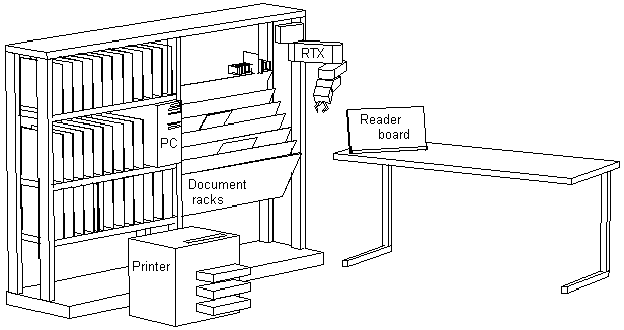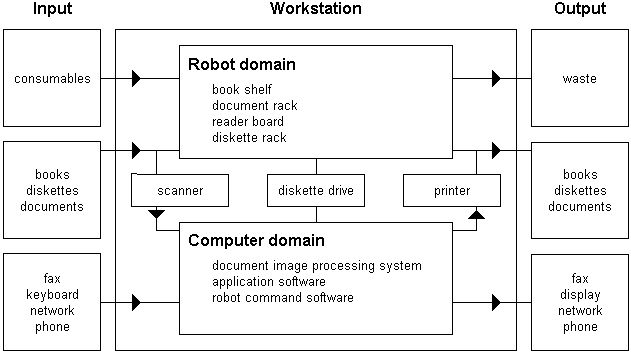The RAID workstation for office environments
John L Dallaway and Robin D Jackson
Department of Engineering
University of Cambridge, UK
Abstract
This paper describes the development of a robotic workstation for use by individuals with little or no upper limb function in office environments. The technical features of the workstation are presented and details of the evaluation process are noted. The demonstrator workstation is specifically configured for applications in Computer Aided Design (CAD).
Background
The RAID (Robot for Assisting the Integration of the Disabled) project exists under the European Community TIDE (Technology for the socio-economic Integration of Disabled and Elderly people) initiative [1]. The RAID consortium consists of academic and industrial partners from France, Sweden and the UK. Development of the demonstrator workstation is now complete and initial user trials are scheduled to commence in March 1993. It is the experience of the RAID partners that projects which are led by the requirements of users have a substantially higher probability of success compared with those which seek to push technology into the marketplace. Considerable emphasis has therefore been placed on the creation and subsequent revision of a user requirements specification. This specification provided a focus within the project during the functional and technical specification phases.
System description
The RAID workstation is based around a custom designed mechanical structure providing storage for books, manuals, paper documents and other reference materials. An RT-series robot arm is mounted on a linear track in front of the storage zones. The robot arm features an extended vertical column which, together with the linear track, provides a considerably enhanced working envelope. A screen dump from a robot simulation system of the conceptual design for the workstation is shown in figure 1. The construction of the storage unit is designed to integrate with existing office furniture and therefore avoid the attraction of unnecessary attention. The appearance of assistive technology has been shown to significantly affect the acceptability of robotic devices [2].

Figure 1. Screen dump of the conceptual workstation layout
The operator sits at an adjustable desk in front and to one side of the robot arm. The arm's working envelope includes a large proportion of the desk area but does not reach to the user for reasons of safety. The demonstrator system employs two interchangeable pneumatic end effectors. One end-effector is designed for the efficient transportation of books around the workstation. It incorporates a ledge on which objects rest to reduce the required clamping force. The other end-effector facilitates diskette manipulation and provides page-turning facilities. It uses a knife action to open books at an approximate indexing point. A suction pad provides for subsequent single page manipulation using a powered finger on the reader board to prevent book closure during page turning. An additional clamping device holds diskettes for transportation between diskette drives and a storage rack.
The control architecture of the workstation is illustrated in figure 2. The standard RT-series IP board is replaced by a transputer-based motor control board to improve the resolution and repeatability of arm motion. The arm gearing and encoders are also upgraded to take advantage of the superior control electronics.

Figure 2. Control architecture of the RAID workstation
Enhanced manipulator-level control facilitates a reduction in cycle time for many manipulative tasks through the use of via points. Arm trajectories are generated using a second transputer located on an ISA PC board. This processor communicates with the motor control board using an RS422-level serial link.
Supervisory control of the robot arm is provided using a Windows version of the MASTER robot control language running on an i486-based PC. The MASTER language allows direct and pre-programmed control of the arm [3]. Repetitive tasks are defined using a programming utility prior to execution. The Microsoft Windows operating environment has been adopted to allow for the integration of the robot control software with vocationally related software such as the CAD application. Operators are therefore able to switch between co-existing computer processes which handle the various aspects of their work.
Communication between the operator and the PC is achieved using an Infra Red (IR) link between a wheelchair-mounted joystick and workstation-mounted mouse emulation hardware. A mode selection switch toggles joystick output between the wheelchair motors and the mouse emulator. Keyboard emulation is provided using the Windows Visual Keyboard (WiViK) [4]. This utility presents an image of a standard keyboard on the Windows desktop and inserts characters into a keyboard buffer when the mouse is clicked on the iconic representations of individual keys. The consistency with which Windows applications access the PC hardware enables a single access utility to support every application.
Tasks
The tasks specified for the RAID workstation were developed in collaboration with a reference group of seven potential users. These individuals are all wheelchair users who have insufficient functions to be able to operate a computer workstation unaided, but who have at least two degrees of movement available for the operation of a joystick, trackball or chin switch. The following techniques were utilised in developing the tasks:
- Individual discussions to establish specific requirements
- Feedback on presentations of possible tasks
- Existing expertise from project collaborators
- Indirect advice from qualified occupational therapists
- Hands-on exercises with prototype devices
The user requirements formed the primary input to a functional specification which represented tasks in terms of the information flow within the workstation [5]. Information may be stored within the workstation in physical form within the robot domain or in electronic form within the computer domain. Information transfer between these two domains is achieved using a scanner, a printer and a diskette drive as shown in figure 3. The RAID system employs a Document Image Processing (DIP) system to minimise paper handling. However, DIP can only be viewed as a partial solution to the document storage requirements of disabled workers since the temporary nature of many large documents renders scanning uneconomic.

Figure 3. Information flow within the RAID workstation
The tasks specified for the RAID demonstrator are those which would be required by a CAD operator during a typical working day. While RAID is suitable for many computer related vocations, CAD presents the greatest challenge to the system due to the quantity and diversity of reference material which must be accessed during the design cycle.
Evaluation
Initial trials of the RAID demonstrator have been designed to provide an evaluation of the system at the following levels:
- User interface characteristics
- Task execution
- Use as a CAD workstation
In evaluating the user interface, the time taken to perform fixed sequences of commands within the Windows environment will be measured. These sequences will include the mouse actions of dragging and double clicking. The typing speed of individuals will be measured within a word processing context. These figures will be compared with those of non-disabled individuals to establish a performance ratio between joystick control and keyboard/mouse control for CAD applications.
Task execution will be evaluated using questionnaires which will be completed following the multiple execution of each task. The individual operators will also have the opportunity to discuss the tasks with each other and draw conclusions from video recordings of their actions.
Assessment of RAID as a CAD workstation will commence when the users have become familiar with the operation of the system. A benchmark sequence of CAD tasks will be used to simulate a typical CAD activity. This sequence will be developed by an experienced CAD worker in order to minimise the consequences of employing less experienced CAD operators in the trials.
References
- Finlay PA, Détriché J-M, Bolmsjö G, Jones T, Jackson RD (1992) Interactive Robotics in a CAD Workstation. RESNA 92 - Proceedings. 103-104
- Birch GE, Cameron W (1990) User Acceptability in Robotic Assistive Devices. ICORR 90 - Conference Proceedings. 83-94
- Détriché J-M, Lesigne B (1991) Man Machine Interface and Programming Aspects of the Robotized System MASTER for Handicapped People. ICORR 91 - Conference Papers. 68-80
- Shein F, Hamann G, Brownlow J, Treviranus J, Milner M, Parnes P (1991) WiViK: A Visual Keyboard for Windows 3.0. RESNA 91 - Proceedings. 160-162
- Dallaway JL, Jackson RD (1992) RAID - A Vocational Robotic Workstation. ICORR 92 - Conference Papers.
This paper may be referenced as follows:
Dallaway JL, Jackson RD (1993) The RAID workstation for office environments. Proceedings of the RESNA 93 Annual Conference. 504-506



